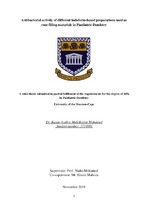| dc.contributor.advisor | Mohamed, Nadia | |
| dc.contributor.author | Mohamed, Razan Azahry Abdelhalim | |
| dc.date.accessioned | 2020-11-23T21:52:20Z | |
| dc.date.available | 2020-11-23T21:52:20Z | |
| dc.date.issued | 2019 | |
| dc.identifier.uri | http://hdl.handle.net/11394/7533 | |
| dc.description | Magister Scientiae Dentium - MSc(Dent) | en_US |
| dc.description.abstract | Background: The primary goal of pulp therapy in the deciduous dentition is to keep the teeth fully functional in order to prevent arch space loss. A pulpectomy is a pulp therapy procedure indicated when an irreversibly inflamed or necrotic radicular pulp is encountered. ZOE and iodoform pastes (i.e. Kri 1 paste and Vitapex) have been recommended as root filling materials after pulpectomy. High clinical success rates have been reported with Vitapex and the fact that it resorbs readily when extruded beyond the apex is an added advantage. However, it has also been reported to resorb from within the root canals and even cause pathological root resorption in cases where the vital pulp is inflamed (Nurko et al., 2000). Iodoform-based preparations are thought to be more appropriate because they fulfill nearly all the requirements of the ideal root filling materials in primary teeth. Despite this, there are limited studies comparing the antibacterial effect of iodoform-based preparations.
Aim: The aim of this study was to evaluate the antibacterial efficacy of Vitapex (V), Kri 1 paste (K) and pure iodoform (I) against E. faecalis. | en_US |
| dc.language.iso | en | en_US |
| dc.publisher | University of the Western Cape | en_US |
| dc.subject | Pulp therapy | en_US |
| dc.subject | Primary teeth | en_US |
| dc.subject | Iodoform-based materials | en_US |
| dc.subject | Enterococcus faecalis | en_US |
| dc.title | Antibacterial activity of different Iodoform-based preparations used as root filling materials in Paediatric Dentistry | en_US |
| dc.rights.holder | University of the Western Cape | en_US |

